air conditioning TOYOTA YARIS HATCHBACK 2012 Owners Manual
[x] Cancel search | Manufacturer: TOYOTA, Model Year: 2012, Model line: YARIS HATCHBACK, Model: TOYOTA YARIS HATCHBACK 2012Pages: 365, PDF Size: 8.17 MB
Page 1 of 365
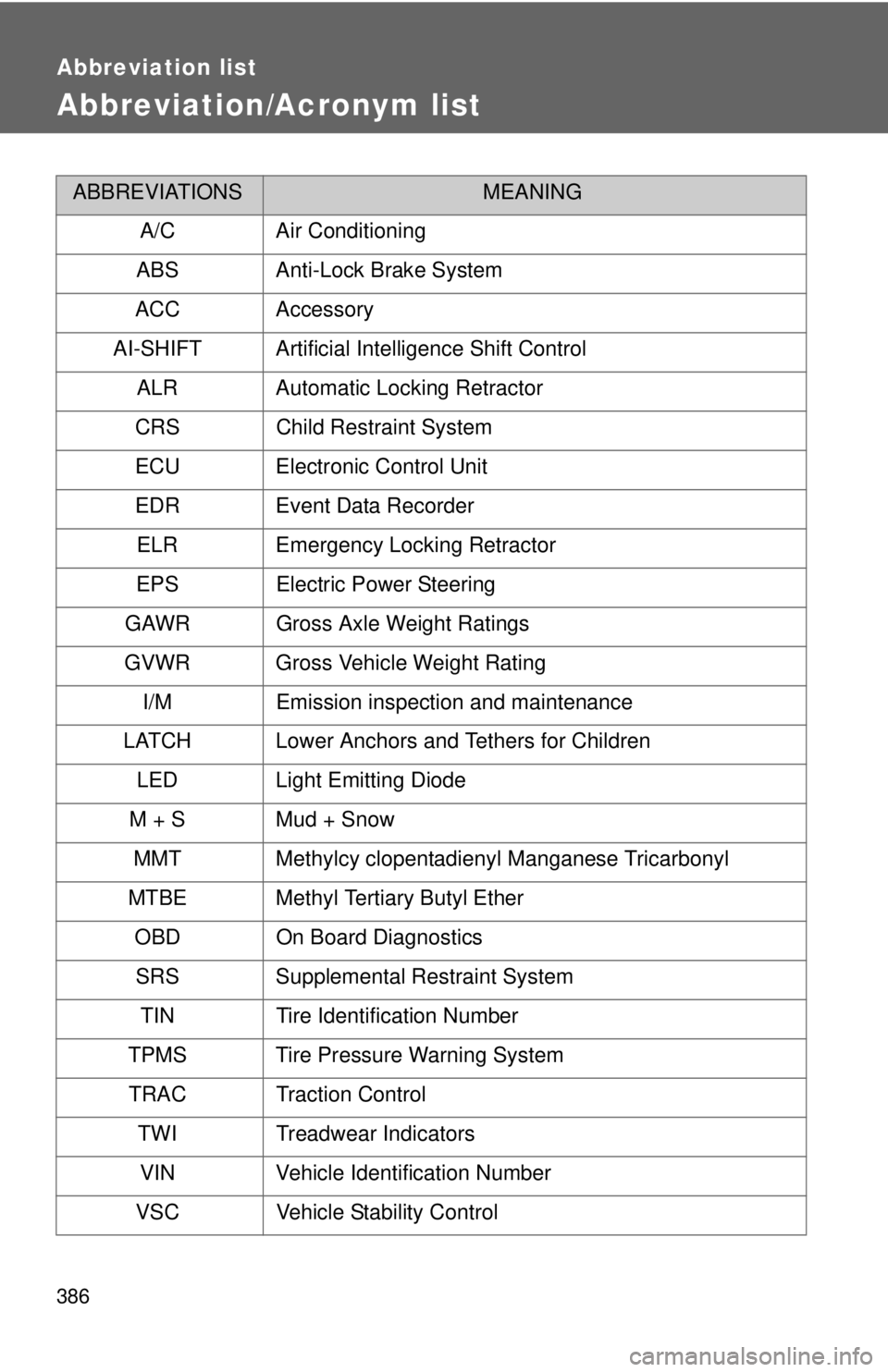
386
Abbreviation list
Abbreviation/Acronym list
ABBREVIATIONSMEANING
A/C Air Conditioning
ABS Anti-Lock Brake System
ACC Accessory
AI-SHIFT Artificial Intelligence Shift Control ALR Automatic Locking Retractor
CRS Child Restraint System
ECU Electronic Control Unit
EDR Event Data Recorder ELR Emergency Locking Retractor
EPS Electric Power Steering
GAWR Gross Axle Weight Ratings
GVWR Gross Vehicle Weight Rating I/M Emission inspection and maintenance
LATCH Lower Anchors and Tethers for Children LED Light Emitting Diode
M + S Mud + Snow
MMT Methylcy clopentadienyl Manganese Tricarbonyl
MTBE Methyl Tertiary Butyl Ether OBD On Board Diagnostics
SRS Supplemental Restraint System TIN Tire Identification Number
TPMS Tire Pressure Warning System
TRAC Traction Control TWI Treadwear IndicatorsVIN Vehicle Identification Number
VSC Vehicle Stability Control
Page 9 of 365

TABLE OF CONTENTS
1
1Before drivingAdjusting and operating features such as door locks,
mirrors, and steering column.
2When drivingDriving, stopping and safe-driving information.
3Interior
featuresAir conditioning and audio systems, as well as other in-
terior features for a comfortable driving experience.
4Maintenance
and careCleaning and protecting your vehicle, performing do-it-
yourself maintenance, and maintenance information.
5When trouble
arisesWhat to do if the vehicle needs to be towed, gets a flat
tire, or is involved in an accident.
6Vehicle
specificationsDetailed vehicle information.
7For ownersReporting safety defects for U.S. owners, seat belt and
SRS airbag instructions for Canadian owners.
IndexAlphabetical listing of information contained in this
manual.
Page 162 of 365

181
2-5. Driving information
2
When driving
●
Crosswinds and rough roads will adversely affect handling of your
vehicle and trailer, causing sway . Periodically check the rear to
prepare for being passed by large trucks or buses, which may
cause your vehicle and trailer to sway. If swaying occurs, firmly grip
the steering wheel, reduce speed immediately but gradually, and
steer straight ahead. Never increase speed. If you make no
extreme correction with the stee ring or brakes, your vehicle and
trailer will stabilize.
● Take care when passing other vehicles. Passing requires consider-
able distance. After passing a vehicle, do not forget the length of
your trailer, and be sure you hav e plenty of room before changing
lanes.
● To maintain engine braking efficiency and charging system perfor-
mance when using engine braking, do not use the transmission in
D (vehicles with an automatic transmission) or 5 (vehicles with a
manual transmission).
● Due to the added load of the trailer, your vehicle’s engine may
overheat on hot days (at temperatures over 85°F [30°C]) when
driving up a long or steep grade. If the high engine coolant temper-
ature warning light flashes or co mes on overheating, immediately
turn off the air conditioning (if in use), pull your vehicle off the road
and stop in a safe place. ( →P. 334)
Page 172 of 365
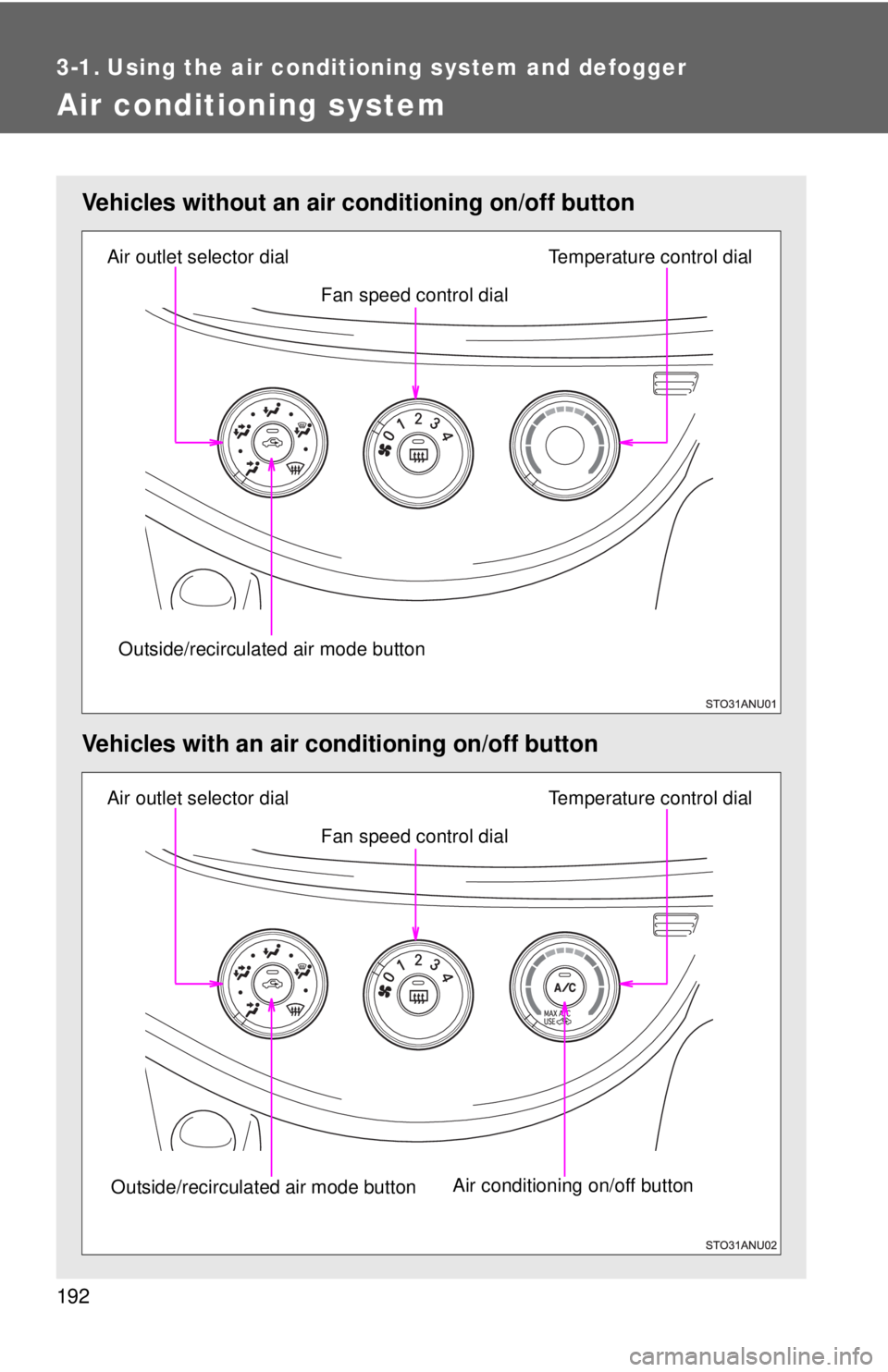
192
3-1. Using the air conditioning system and defogger
Air conditioning system
Vehicles without an air conditioning on/off button
Vehicles with an air conditioning on/off button
Fan speed control dial
Air outlet selector dial Temperature control dial
Outside/recirculated air mode button
Fan speed control dial
Air outlet selector dial Temperature control dial
Outside/recirculated air mode button
Air conditioning on/off button
Page 173 of 365
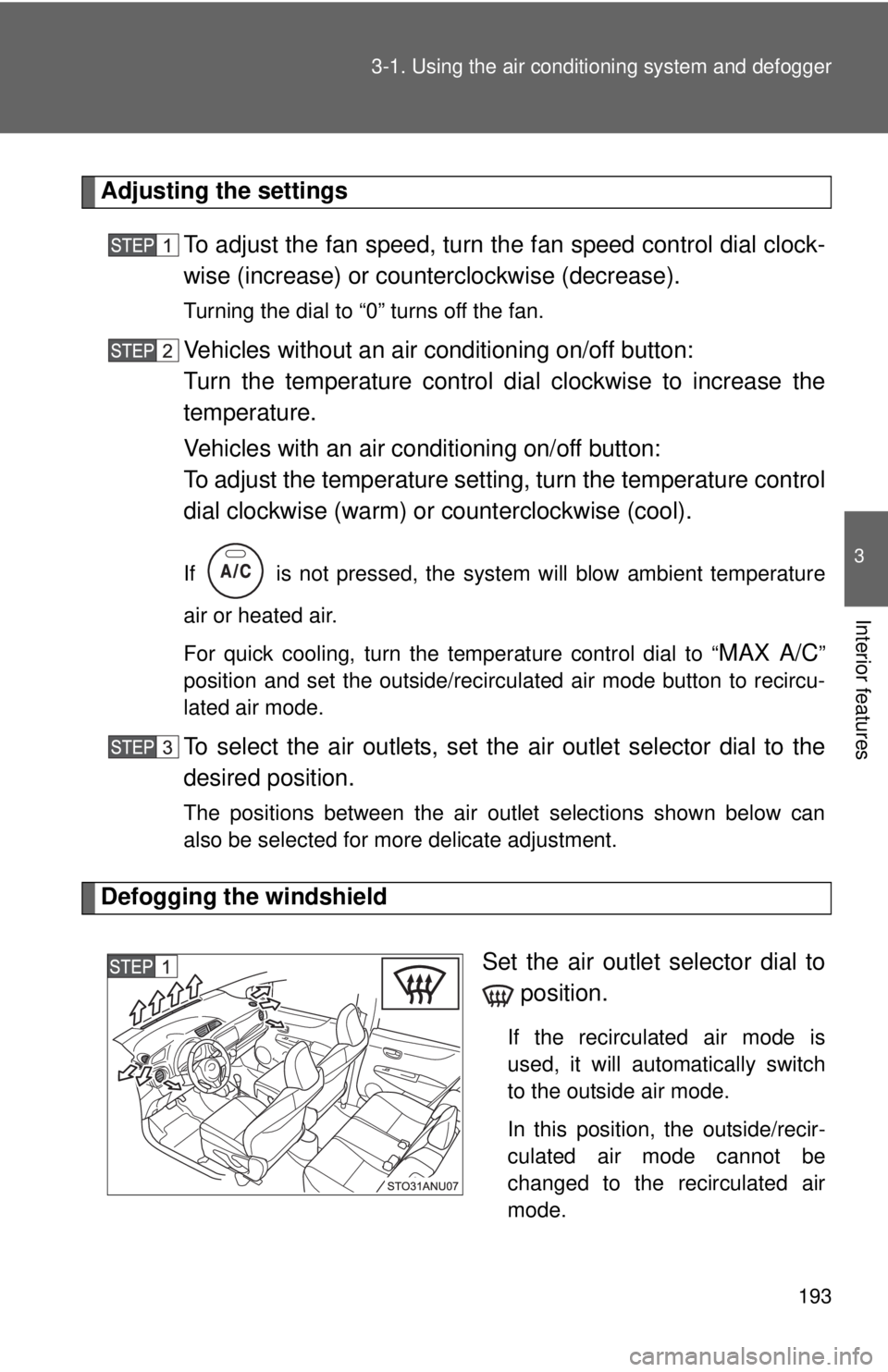
193
3-1. Using the air conditioning system
and defogger
3
Interior features
Adjusting the settings
To adjust the fan speed, turn the fan speed control dial clock-
wise (increase) or count erclockwise (decrease).
Turning the dial to “0” turns off the fan.
Vehicles without an air conditioning on/off button:
Turn the temperature control di al clockwise to increase the
temperature.
Vehicles with an air conditioning on/off button:
To adjust the temperature setting, turn the temperature control
dial clockwise (warm) or counterclockwise (cool).
If is not pressed, the system will blow ambient temperature
air or heated air.
For quick cooling, turn the temperature control dial to “
MAX A/C”
position and set the outside/recirculated air mode button to recircu-
lated air mode.
To select the air outlets, set the air outlet selector dial to the
desired position.
The positions between the air outlet selections shown below can
also be selected for more delicate adjustment.
Defogging the windshield
Set the air outlet selector dial to position.
If the recirculated air mode is
used, it will automatically switch
to the outside air mode.
In this position, the outside/recir-
culated air mode cannot be
changed to the recirculated air
mode.
Page 174 of 365

194 3-1. Using the air conditioning system and defogger
Perform the following operations accordingly:
●To adjust the fan speed, turn the fan speed control dial.
● To adjust the temperature setting, turn the temperature con-
trol dial.
● If the dehumidificat ion function is not operating, press
to operate the dehumidification function.
To defog the windshield and the side windows early, turn the air flow
and temperature up.
Air outlets and air flow
Air flows to the upper body.
Air flows to the upper body and
feet.
: Some models
Page 175 of 365

195
3-1. Using the air conditioning system
and defogger
3
Interior features
Air flows mainly to the feet.
: Some models
Air flows to the feet and the
windshield defogger operates.
If the recirculated air mode is
used, it will automatically switch
to the outside air mode.
In this position, the outside/recir-
culated air mode cannot be
changed to the recirculated air
mode.
Switching between outside air and recirculated air modes
Press .
The mode switches between outside air mode (introduces air from
outside the vehicle) (indicator off) and recirculated air mode (recy-
cles air inside the vehicle) (indicator on) each time the button is
pressed.
: Some models
Page 176 of 365
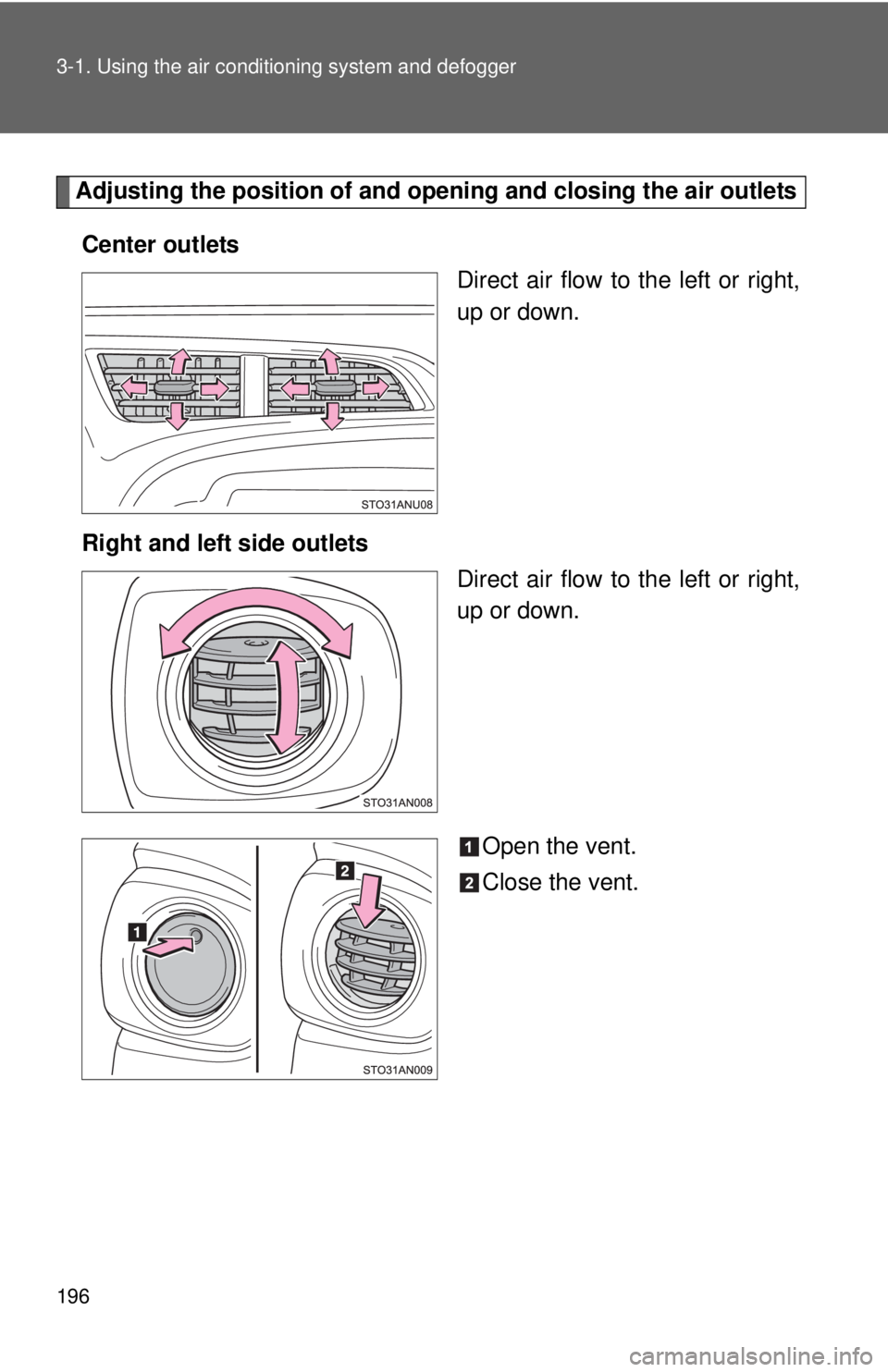
196 3-1. Using the air conditioning system and defogger
Adjusting the position of and opening and closing the air outlets
Center outlets Direct air flow to the left or right,
up or down.
Right and left side outlets Direct air flow to the left or right,
up or down.
Open the vent.
Close the vent.
Page 177 of 365
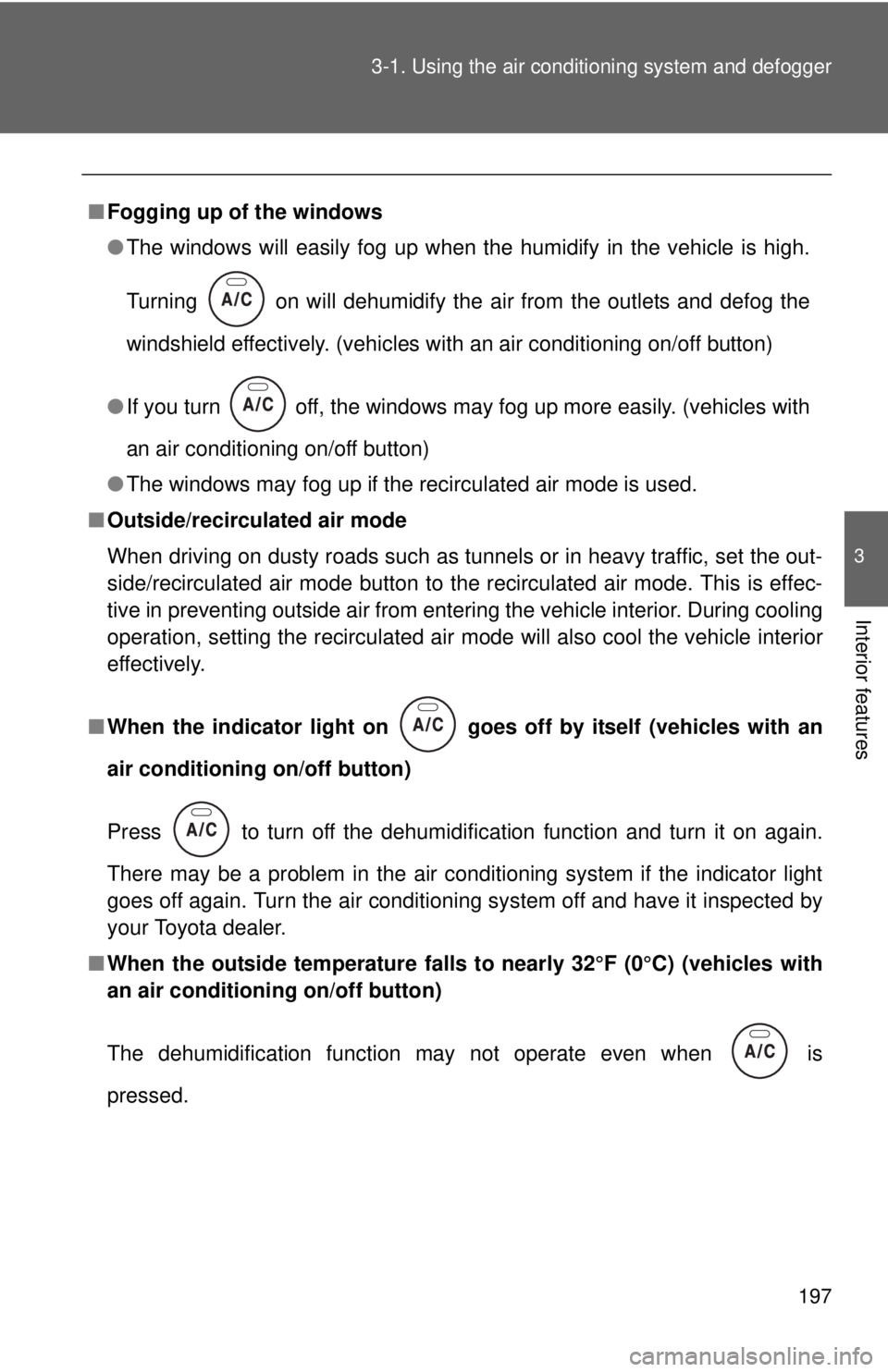
197
3-1. Using the air conditioning system
and defogger
3
Interior features
■Fogging up of the windows
●The windows will easily fog up when the humidify in the vehicle is high.
Turning on will dehumidify the air from the outlets and defog the
windshield effectively. (vehicles with an air conditioning on/off button)
● If you turn off, the windows may fog up more easily. (vehicles with
an air conditioning on/off button)
● The windows may fog up if the recirculated air mode is used.
■ Outside/recirculated air mode
When driving on dusty roads such as tunnels or in heavy traffic, set the out-
side/recirculated air mode button to the recirculated air mode. This is effec-
tive in preventing outside air from enter ing the vehicle interior. During cooling
operation, setting the recirculated air m ode will also cool the vehicle interior
effectively.
■ When the indicator light on goes off by itself (vehicles with an
air conditioning on/off button)
Press to turn off the dehumidification function and turn it on again.
There may be a problem in the air conditioning system if the indicator light
goes off again. Turn the air conditioning system off and have it inspected by
your Toyota dealer.
■ When the outside temperature falls to nearly 32°F (0°C) (vehicles with
an air conditioning on/off button)
The dehumidification function may not operate even when
is
pressed.
Page 178 of 365
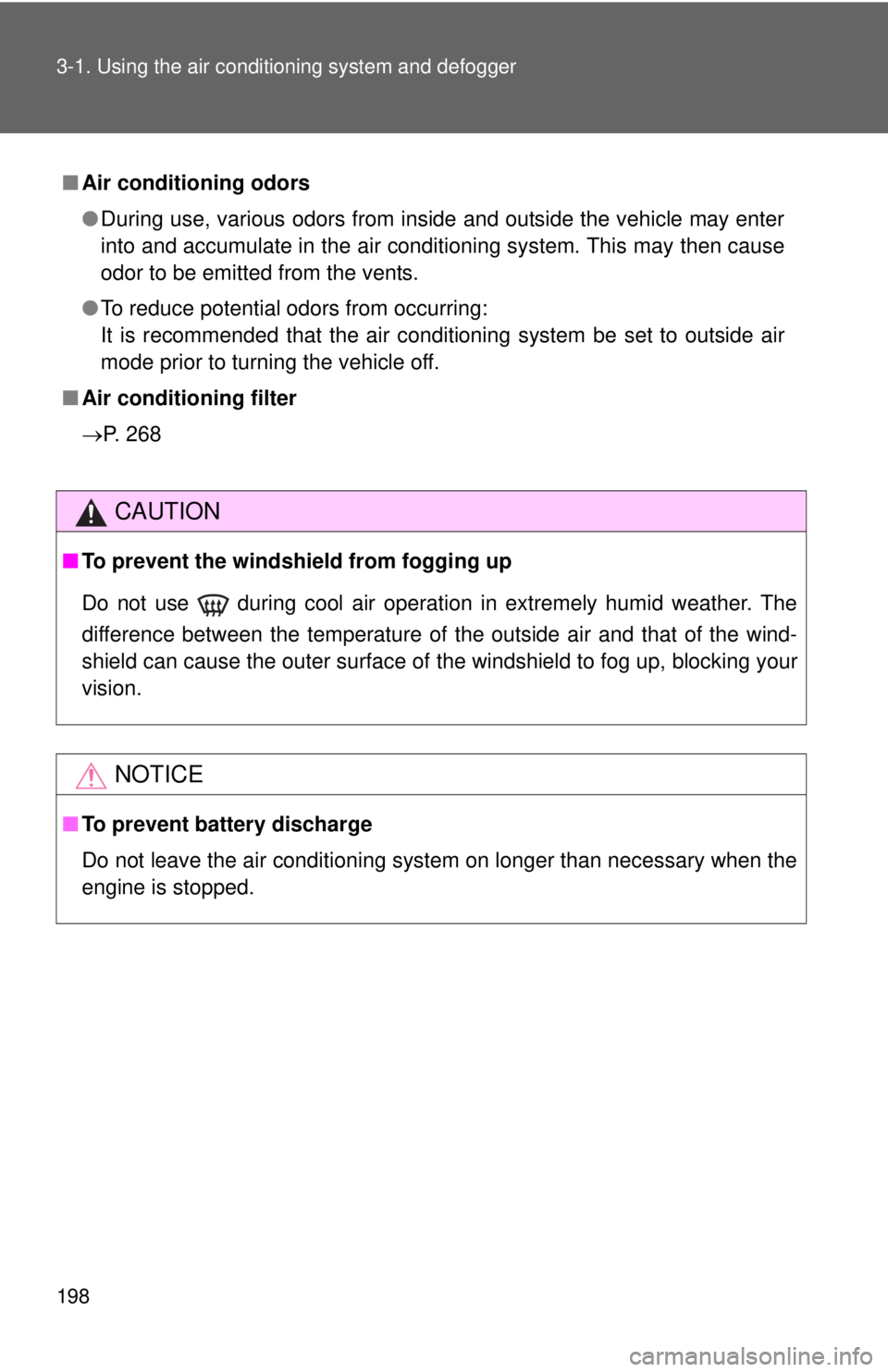
198 3-1. Using the air conditioning system and defogger
■Air conditioning odors
●During use, various odors from inside and outside the vehicle may enter
into and accumulate in the air conditioning system. This may then cause
odor to be emitted from the vents.
● To reduce potential odors from occurring:
It is recommended that the air conditioning system be set to outside air
mode prior to turning the vehicle off.
■ Air conditioning filter
→ P. 268
CAUTION
■To prevent the windshield from fogging up
Do not use during cool air operation in extremely humid weather. The
difference between the temperature of the outside air and that of the wind-
shield can cause the outer surface of the windshield to fog up, blocking your
vision.
NOTICE
■To prevent battery discharge
Do not leave the air conditioning system on longer than necessary when the
engine is stopped.